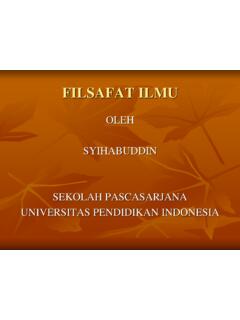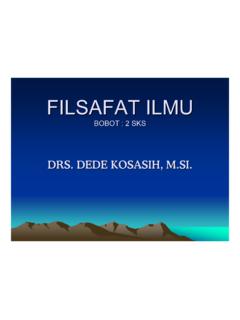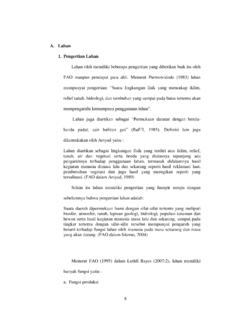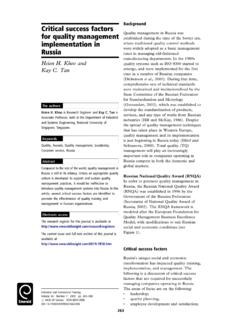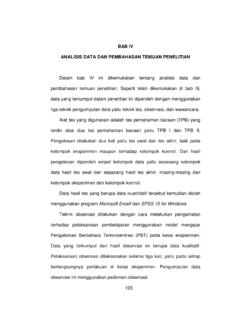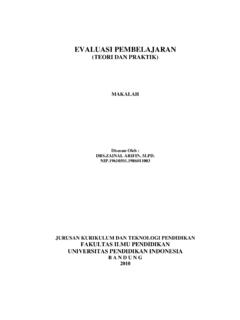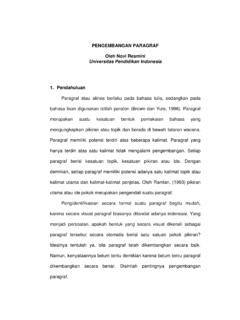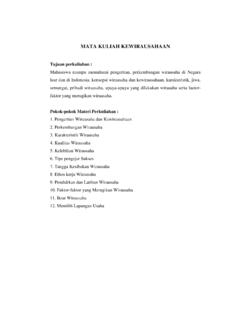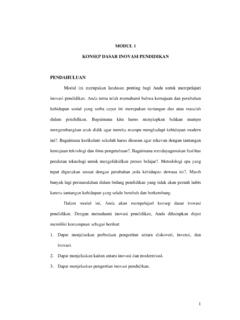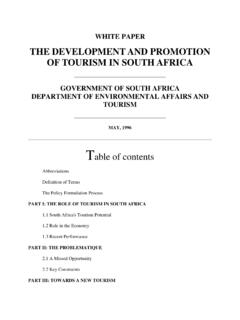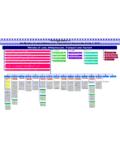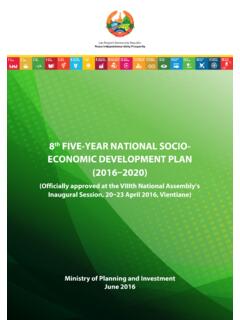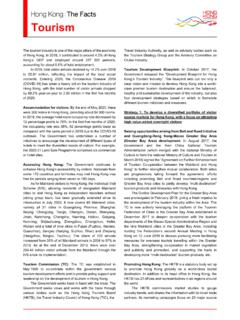Transcription of TOURISM PLANNING APPROACHES
1 TOURISM PLANNING APPROACHES . 1. BOOSTERISM. Underlying assumptions and related Examples of related methods attitudes promotion TOURISM is inherently good TOURISM should be developed public relations cultural and natural resources should advertising be exploited growth target industry as expert development defined in business/. corporate terms Examples of related models demand forecasting models Definition of the TOURISM PLANNING problem how many tourists can be attracted and Examples of related literature accommodated? Usually associated with TOURISM policy how can obstacles be overcome? statements convincing hosts to be good to tourists 2. ECONOMIC. Examples of related methods Underlying assumptions and related supply-demand analysis attitudes benefit-cost analysis TOURISM equal to other industries product-market matching use TOURISM to: create employment, earn development incentives foreign revenue and improve terms of trade, encourage regional development , market segmentation overcome regional economic disparities planner as expert Examples of related models development defined in economic terms management processes TOURISM master plans Definition of the TOURISM PLANNING motivation problem economic impact can TOURISM be used as a growth pole?
2 Economic multipliers maximisation of income and employment hedonistic pricing multipliers influencing consumer choice Examples of related literature providing economic values for Economic impact statements & feasibility externalities studies. Examples would be analyses of the potential benefits of hosting an providing economic values for Olympic games. conservation purposes 3. PHYSICAL/ SPATIAL. Underlying assumptions and related Examples of related methods attitudes ecological studies TOURISM as a resource user environmental impact assessment regional PLANNING ecological basis to development perceptual studies TOURISM as a spatial and regional phenomenon Examples of related models environmental conservation spatial patterns and processes development defined in environmental physical impacts terms resort morphology preservation of genetic diversity LAC (limits of acceptable change).
3 ROS (recreational opportunity spectrum). Definition of the TOURISM PLANNING TOS ( TOURISM opportunity spectrum). problem destination lifecycles physical carrying capacity manipulating travel patterns and visitor flows Examples of related literature visitor management Gunn 1994;. concentration or dispersal of visitors Inskeep 1991;. Dowling 1997. perceptions of natural environment widerness and national park management designation of environmentally sensitive areas 4. COMMUNITY. Underlying assumptions and related attitudes Examples of related methods need for local control community development search for balanced development awareness and education search for alternatives to mass' attitudinal surveys TOURISM development social impact assessment planner as facilitator rather than expert Examples of related models development defined in socio- ecological view of community cultural terms social/perceptual carrying capacity attitudinal change Definition of the TOURISM PLANNING social multiplier problem how to foster community control?
4 Examples of related literature understanding community attitudes towards TOURISM Murphy 1985;. understanding the impacts of Blank 1989;. TOURISM on a community Macbeth 1997. social impact 5. SUSTAINABLE. Underlying assumptions and related Definition of the TOURISM PLANNING attitudes problem integration of economic, environmental and socio-cultural values understanding the TOURISM system TOURISM PLANNING integrated with other setting goals, objectives and priorities PLANNING processes achieving policy and administrative holistic PLANNING coordination in and between the public and private sectors preservation of essential ecological processes cooperative and integrated control systems protection of human heritage and biodiversity understanding the political dimensions of inter- and intra- generational equity TOURISM achievement of a better balance of fairness PLANNING for TOURISM that meets local and opportunity between nations needs and trades successfully in a PLANNING and policy as argument competitive marketplace PLANNING asprocess PLANNING and implementation as two sides of the same coin recognition of political dimension of TOURISM Contd.
5 TOURISM PLANNING Approach Prepared by Dr. M. Liga Suryadana 5. SUSTAINABLE (contd.). Examples of related methods Examples of related models strategic PLANNING to supersede systems models conventional APPROACHES integrated models focused on places and raising producer awareness links and relationships between such places raising consumer awareness resources as culturally constituted raising community awareness environmental perception stakeholder input business ecology policay analysis learning organisations evaluative research political economy aspirations analysis Examples of related literature stakeholder audit Krippendorf 1987;. environmental analysis and audit Hall & McArthur 1996, 1998;. interpretation Mathieson & Wall 1982;. McKercher 1997.
6 Lindberg & McKercher 1997. Source: After Getz (1987), Hall et al. (1997), in Hall, 2000: 24. The Four Characteristics of a Sustainable Community Economic security A more sustainable community includes a variety of businesses, industries, and institutions which are environmentally sound (in all aspects), financially viable, provide training, education, and other forms of assistance to adjust to future needs, provide jobs and spend money within a community, and enable employees to have a voice in decisions which affect them. A more sustainable community also is one in which residents' money remains in the community. Ecological integrity A more sustainable community is in harmony with natural systems by reducing and converting waste into non-harmful and beneficial purposes, and by utilizing the natural ability of environmental resources for human needs without undermining their ability to function over time.
7 Quality of life A more sustainable community recognizes and supports people's evolving sense of well-being which includes a sense of belonging, a sense of place, a sense of self-woth, a sense of safety, a sense of connection with nature, and provision of goods and services which meet their needs, both as they define them and as can be accommodated within the ecological integrity of natural systems. Empowerment and responsibility A more sustainable community enables people to feel empowered and to take responsibility based on a shared vision, equal opportunity, ability to access expertise and knowledge for their own needs, and a capacity to affect positively the outcome of decisions which affect them. Source: after Winspread Journal 1997, in , 2000:209.
8 Basic Studies essential in preparing a comprehensive TOURISM development plan 1. The tourist market: its origin, form, needs, rate of growth and competition for it. 2. The physical capacity of the area: its ability to absorb the requirements of TOURISM in terms of its natural attractions, infrastructure and economic resources. socio-economic impact on local communities: migration, housing and social infrastructure for the support population. 4. The environmental capacity of the area: the limits imposed upon tourist development to protect the quality of the area in terms of landscape, townscape, tranquillity and culture (source: Shankland Cox Partnership, UK, in , 2000: 171). INITIATION OF PROCESS. Stakeholder demands THE MANAGEMENT ENVIRONMENT.
9 (after Hall & McArthur, in CMHall, TOURISM PLANNING , 2000, 78). Perceived need Response to crisis STRATEGIC TOURISM PLANNING PROCESS. PURPOSE. What are we trying to achieve? Why are we doing this? INDICATORS. What are our limitations? STRATEGIC ANALYSIS. DECISIONS AND NON-DECISIONS. Environmental analysis, what factors are affecting us? MONITORING AND EVALUATION. Market analysis, how do our visitors perceive us? Competitor analysis, where else do people visit? Resource analysis, do our staff have appropriate skills? Aspirations analysis, what do stakeholders seek? Situation analysis, how appropriate is our vision? after Hall & McArthur, in CMHall, 2000, 78. VISION, GOAL AND OBJECTIVE SETTING. Long-term: Strategic plans Vision, goals & objectives Mid-term: Operating and INDICATORS.
10 Goals & objectives action plans Short-term: Day - to - day Objectives decisions TOURISM MANAGEMENT METHODS, TOOLS & TECHNIQUES. - the tools and techniques which give effect to the mission, goals & objectives, visitor research & monitoring, marketing, interpretation, community consultation, impact statements, forecasting & resource management The TOURISM Market System THE TOURIST (Demand). Culture Behavioural setting Motivations Physiological - Social - Cultural - Spiritual - Fantasy - Escape Information, past experiences and preferences Expectations and image Personal IMPACTS THE TOURIST EXPERIENCE. Economic The TOURISM Industry THE TOURIST PRODUCT (Supply). Soci0-cultural Environment Travel operators Souvenir manufacturers Political Accommodation Convention centres Restaurants Casinos Visitor centres Specialist retailers Travel agents Tour Operators Events & festivals promotion & Advertising Attraction & entertainment facility operators Government National - State - Regional - Local Co-ordination PLANNING Government as entrepreneur Legislation & regulation Stimulation Social TOURISM Socio-cultural - Resources - Natural Source: , 2000, 52.
